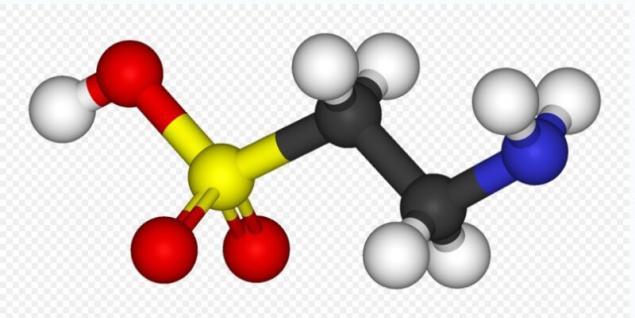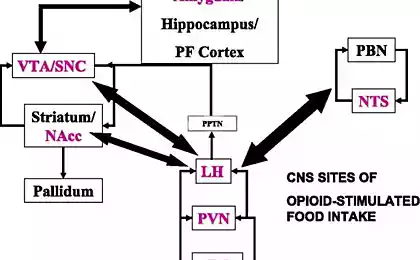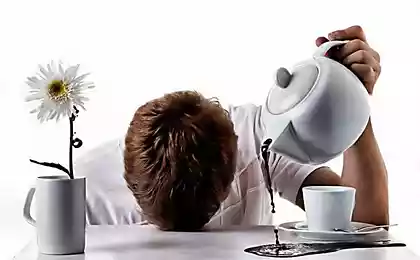538
The role of taurine in the metabolism and its deficiency in the body
The article considers the role of taurine in metabolism, its deficiency and effects that occur when you are Troubleshooting a lack of taurine in the body. Discusses the contribution of taurine in the prevention and treatment of diabetes and its complications and in reducing the risks of cardiovascular diseases.
Taurine (2-aminoethanesulfonic acid) is the end product of metabolism of amino acidscontaining sulfur (methionine, cysteine, homocysteine, cystine). A key role in the synthesis of taurine in animals the enzyme plays containsalias the decarboxylase activity which in humans is limited. Therefore, the source of taurine for humans is mostly animal food, because the plant taurine is not found. Similar to human some kinds of animals can also get taurine with food.
The record for the content of taurine are seafood.

Built in the early nineteenth century, taurine has attracted the attention of researchers only in the mid-twentieth century.
In most cases, taurine is described as the main osmoregulator cells, membrane protector, regulator of intracellular calcium with the antioxidant, detoxifier, which is involved in the metabolism of fats and fat-soluble vitamins, affect inflammatory processes.
In addition, it should be noted another potentially important reaction: the interaction of taurine and uridine with the formation of 5-tournamentsarizona, resulting in modification of tRNA in the mitochondria, affects mitochondrial protein synthesis.
There are reports of therapeutic effects of taurine in the treatment of epilepsy, tissue ischemia, obesity, diabetes mellitus type 2, arterial hypertension, congestive heart failure. Taurine had a beneficial effect on the blood vessels of smokers, patients receiving methotrexate, alcoholism, myocardial infarction. The content of taurine was investigated during neurodegenerative processes in the elderly, when radiation sickness.
Beneficial effect of taurine at such various diseases is detected only if in the organism there is a deficiency. If the body is not a deficit of this substrate, its use has no impact – neither positive nor negative.
Since the physiological function of taurine is varied, diverse and effects from its use.
The maximum dose that was tested in the clinic and did not cause any toxic manifestation was 15 g/day. For acute and chronic introduction of taurine in very high doses (1 g/kg) there were no deaths in experimental animals.
The consequences of taurine deficiency for animals
Concentration of substance in plasma of animals of less than 30 µmol/l is regarded as a deficiency. Deficiency of taurine causes a dilated cardiomyopathy in cats. In addition, deficiency of taurine in cats change the parameters of anticoagulant and fibrinolytic activity of blood, develops retinal degeneration, cardiomyopathy, changes the function of white blood cells, disorders of growth and development.
The elimination of the deficit of taurine significantly improves these indicators, as well as the survival prognosis of animals and myocardial function.
Deficiency of taurine can cause dilated cardiomyopathy and in dogs. In dogs some breeds there was a significant improvement of myocardial function after adding taurine to the diet. The normal concentration of taurine in blood plasma of dogs is 50-180 nmol/ml. the Addition of taurine and carnitine dogs significantly improves the prognosis of dilated cardiomyopathy.
One of the models to study the role of taurine are animal who have turned off the gene responsible for the synthesis of transport laurinovoj system (TauTKO). It is known that taurine penetrates into the cells of animals against a concentration gradient via the high-affinity transport system. In mice deprived of such a transport system, an increase in mRNA expression of the sodium - eroticheskogo hormone in the brain and heavy chains of β-myosin. The ability of these mice to perform physical activity (in this study – to swim) falls in 10 times. Animals develop cardiomyopathy, there is dysfunction of organs of vision, hearing, kidney, liver.
All this testifies to the important role of taurine in the work of many organs and systems of animals.

Taurine in human milk and artificial feeding children
Interestingly enough a study in which premature infants born in 1982-1985, set a standard feeding plan, developed for children born at term. Subsequently, in tests on mental development (Bayley mental development index) at 18 months, and mathematical ability (WISC-R arithmetic subtest) to 7 years of age revealed that these children had lower development indicators than those who received artificial feeding, the appropriate standards of nutrition for preterm infants, ie, enriched with various nutrients.
We put forward the hypothesis that taurine is necessary for normal mental development. Comparative analysis of ingredients contained in baby food, showed that taurine is a nutrient, which may explain this phenomenon. It also discusses the role of taurine in normal brain development and its role as antioxidant.
Taurine for the elderly and after injury
The change in the level of taurine in the elderly also affects metabolism. Jeevanandam et al. showed that the concentration of taurine in blood plasma of older age is 46 ± 3 µmol/l, and young – 81 ± 7 µmol/L. After the injury, the level of taurine in elderly patients falling even more – up to 30 ± 5 µmol/l, while the young – to 33 ± 5 µmol/L. Thus, it is possible to speak about expediency of additional consumption of taurine in the elderly and in young age – after injury or surgery.
Taurine and cardiovascular risk
In 1982-2005. Y. Yamori (Institute for world health development, University of Mukogawa, Japan) conducted a large-scale multicenter epidemiological study CARDIAC (Cardiovascular Diseases and Alimentary comparison – a comparison of cardiovascular morbidity and dietary habits), in cooperation with the who, which was attended by men and women of the 61 population. The study revealed an inverse correlation between the consumption of taurine and mortality from coronary heart disease. Data analysis using the method of stepwise linear regression showed that mortality from ischemic heart disease by 59 % due to taurine deficiency and the ratio of n-3 polyunsaturated to saturated fatty acids in the diet.
Average consumption of taurine (this is judged by its urinary excretion) in our country is very low. So, women living in Moscow, the average amount excreted in the urine taurine is 127 mmol/ day, the residents of Beppu (Japan) – 1590 µmol/day. In accordance with the results of this study suggest that mortality is higher in Russia than in Japan, which is true.
We compared populations consuming large quantities of taurine with food (> 639,4 mmol/ day), and populations with the consumption of taurine < 639,4 mmol/day. It turned out that the regions with large consumption of taurine have lower cardiovascular risks (significantly less levels of total cholesterol, blood pressure, body mass index and atherogenic index).

Taurine and diabetes
Numerous studies show that the taurine content in tissues from patients with DM significantly reduced. This may be due to the accumulation of sorbitol in the tissues when activated Paleologo ways of glucose oxidation in conditions of hyperglycemia. On the one hand, this leads to a decrease in the synthesis of taurine in the cells, and on the other hand, a decrease in the activity of glutathione reductase and, consequently, to a decrease in the recovery of oxidized glutathione, leading to oxidative stress in cells.
It is shown that taurine reduces the content of sorbitol in conditions of hyperglycaemia, thus exhibiting antioxidant properties. As you know, the main cause of death in patients with diabetes coronary heart disease. A key role in its development played by endothelial dysfunction, dyslipidemia and increased platelet aggregation. Discovered that taurine is able to bind lipid hydroperoxides, violating the integrity of the endothelial epithelium, and thus prevent apoptosis of cells and development of endothelial dysfunction. Taurine is in the composition taurocholic bile acids are actively involved in the excretion of cholesterol. It is shown that taurine lowers cholesterol in rats receiving atherogenic diet.
The decrease in the content of taurine in platelets of diabetic patients leads to increased intracellular Ca 2+ in them, because this substance is an important regulator of intracellular calcium. This is accompanied by increasing aggregation capacity of platelets and increased risk of thrombosis. The use of taurine patients with DM accompanied by a decrease in hyperreactivity of platelets.
It is well known the value of activation Paleologo ways of glucose oxidation in the Genesis of diabetic retinopathy, cataract surgery, neuro - and nephropathy. The intracellular accumulation of sorbitol leads to the so-called osmotic and oxidative stress. Thus, it is logical to use of taurine as osmoregulator and antioxidant in the prevention of progression of diabetic complications.
For type 2 diabetes characterized by progressive insulin insufficiency, ultimately leading to the need for transfer of patients on substitution insulin therapy. The development of insulin deficiency in type 2 diabetes is associated with the effect of glucotoxicity due to induction of oxidative stress and apoptosis of β-cells of the pancreas. Protective role of taurine shown in experiments on isolated islets of Langerhans in conditions of oxidative stress induced by high concentrations of glucose or fatty acids.
Taurine is a necessary amino acid for the formation of normal insulinsecreting function of islets during fetal development. In the study of insulin secretion in newborn rat pups it was shown that the secretory ability of β-cells of rat pups whose mothers received a low protein diet during pregnancy were significantly reduced compared to control. At the same time, rat pups whose mothers during gestation received taurine with a low protein diet, insulin secretion did not differ from the control.
These data suggest a connection between the decline in taurine levels during pregnancy and development of type 2 diabetes in the offspring in the future.
One of the major pathogenetic factors in the development of type 2 diabetes is insulin resistance, which progresses with the development of metabolic disorders associated with oxidative stress. When the autoxidation of glucose under conditions of hyperglycemia, excessive formation of diacylglycerol – the stimulant of the activity of protein kinase C (PKC).
Activation of PKC leads to the violation signal through the insulin receptors of cells. Taurine inhibits the activity of PKS by reducing the production of diacylglycerol. Studying insulin sensitivity in rats with spontaneous obesity and type 2 diabetes, Y. Nakaya et al. found increased sensitivity to insulin, associated with improved lipid metabolism, reducing the oxidizability of lipoproteins and the level of peroxynitrite (indirect marker of oxidative stress), suggesting an indirect antioxidant effect of taurine.
Gestational diabetes
In one of the studies a total of 72 women, 43 of them with gestational diabetes mellitus (GDM) history, 7 with impaired glucose tolerance (IGT) and 22 with normal glucose tolerance. Glucose tolerance test conducted at 24-28 weeks of pregnancy.
It was found that taurine in plasma is significantly lower in women with a history of GDM, but not in women with NTG. In addition, the level of taurine in plasma was inversely proportional to the area under the curve of glucose before pregnancy and relative C-peptide/ glucose during and after pregnancy (p < 0.05). The relative risk (RR) of glucose metabolism disorders during previous pregnancies (GDM + IGT) increased with decrease in the level of taurine and adjustment for age, body mass index, presence of history of diabetes (RR = 0.980-x; p = 0.003). Thus, the content of taurine in plasma may serve as a marker of the changes of glucose metabolism in women with GDM.
So, deficiency of taurine has been observed in various diseases. Currently, it is possible to speak about the important role of taurine as a modulator of many pathophysiological processes in the human body. There is reason to believe that sufficient intake of taurine and addressing its deficiency in the body will more effectively deal with many chronic non-communicable diseases.published
Author: Michael Borisov
Self-medication can be life-threatening, for advice about the use of any medication, contact your doctor.
Source: www.medi.ru/
Taurine (2-aminoethanesulfonic acid) is the end product of metabolism of amino acidscontaining sulfur (methionine, cysteine, homocysteine, cystine). A key role in the synthesis of taurine in animals the enzyme plays containsalias the decarboxylase activity which in humans is limited. Therefore, the source of taurine for humans is mostly animal food, because the plant taurine is not found. Similar to human some kinds of animals can also get taurine with food.
The record for the content of taurine are seafood.

Built in the early nineteenth century, taurine has attracted the attention of researchers only in the mid-twentieth century.
In most cases, taurine is described as the main osmoregulator cells, membrane protector, regulator of intracellular calcium with the antioxidant, detoxifier, which is involved in the metabolism of fats and fat-soluble vitamins, affect inflammatory processes.
In addition, it should be noted another potentially important reaction: the interaction of taurine and uridine with the formation of 5-tournamentsarizona, resulting in modification of tRNA in the mitochondria, affects mitochondrial protein synthesis.
There are reports of therapeutic effects of taurine in the treatment of epilepsy, tissue ischemia, obesity, diabetes mellitus type 2, arterial hypertension, congestive heart failure. Taurine had a beneficial effect on the blood vessels of smokers, patients receiving methotrexate, alcoholism, myocardial infarction. The content of taurine was investigated during neurodegenerative processes in the elderly, when radiation sickness.
Beneficial effect of taurine at such various diseases is detected only if in the organism there is a deficiency. If the body is not a deficit of this substrate, its use has no impact – neither positive nor negative.
Since the physiological function of taurine is varied, diverse and effects from its use.
The maximum dose that was tested in the clinic and did not cause any toxic manifestation was 15 g/day. For acute and chronic introduction of taurine in very high doses (1 g/kg) there were no deaths in experimental animals.
The consequences of taurine deficiency for animals
Concentration of substance in plasma of animals of less than 30 µmol/l is regarded as a deficiency. Deficiency of taurine causes a dilated cardiomyopathy in cats. In addition, deficiency of taurine in cats change the parameters of anticoagulant and fibrinolytic activity of blood, develops retinal degeneration, cardiomyopathy, changes the function of white blood cells, disorders of growth and development.
The elimination of the deficit of taurine significantly improves these indicators, as well as the survival prognosis of animals and myocardial function.
Deficiency of taurine can cause dilated cardiomyopathy and in dogs. In dogs some breeds there was a significant improvement of myocardial function after adding taurine to the diet. The normal concentration of taurine in blood plasma of dogs is 50-180 nmol/ml. the Addition of taurine and carnitine dogs significantly improves the prognosis of dilated cardiomyopathy.
One of the models to study the role of taurine are animal who have turned off the gene responsible for the synthesis of transport laurinovoj system (TauTKO). It is known that taurine penetrates into the cells of animals against a concentration gradient via the high-affinity transport system. In mice deprived of such a transport system, an increase in mRNA expression of the sodium - eroticheskogo hormone in the brain and heavy chains of β-myosin. The ability of these mice to perform physical activity (in this study – to swim) falls in 10 times. Animals develop cardiomyopathy, there is dysfunction of organs of vision, hearing, kidney, liver.
All this testifies to the important role of taurine in the work of many organs and systems of animals.

Taurine in human milk and artificial feeding children
Interestingly enough a study in which premature infants born in 1982-1985, set a standard feeding plan, developed for children born at term. Subsequently, in tests on mental development (Bayley mental development index) at 18 months, and mathematical ability (WISC-R arithmetic subtest) to 7 years of age revealed that these children had lower development indicators than those who received artificial feeding, the appropriate standards of nutrition for preterm infants, ie, enriched with various nutrients.
We put forward the hypothesis that taurine is necessary for normal mental development. Comparative analysis of ingredients contained in baby food, showed that taurine is a nutrient, which may explain this phenomenon. It also discusses the role of taurine in normal brain development and its role as antioxidant.
Taurine for the elderly and after injury
The change in the level of taurine in the elderly also affects metabolism. Jeevanandam et al. showed that the concentration of taurine in blood plasma of older age is 46 ± 3 µmol/l, and young – 81 ± 7 µmol/L. After the injury, the level of taurine in elderly patients falling even more – up to 30 ± 5 µmol/l, while the young – to 33 ± 5 µmol/L. Thus, it is possible to speak about expediency of additional consumption of taurine in the elderly and in young age – after injury or surgery.
Taurine and cardiovascular risk
In 1982-2005. Y. Yamori (Institute for world health development, University of Mukogawa, Japan) conducted a large-scale multicenter epidemiological study CARDIAC (Cardiovascular Diseases and Alimentary comparison – a comparison of cardiovascular morbidity and dietary habits), in cooperation with the who, which was attended by men and women of the 61 population. The study revealed an inverse correlation between the consumption of taurine and mortality from coronary heart disease. Data analysis using the method of stepwise linear regression showed that mortality from ischemic heart disease by 59 % due to taurine deficiency and the ratio of n-3 polyunsaturated to saturated fatty acids in the diet.
Average consumption of taurine (this is judged by its urinary excretion) in our country is very low. So, women living in Moscow, the average amount excreted in the urine taurine is 127 mmol/ day, the residents of Beppu (Japan) – 1590 µmol/day. In accordance with the results of this study suggest that mortality is higher in Russia than in Japan, which is true.
We compared populations consuming large quantities of taurine with food (> 639,4 mmol/ day), and populations with the consumption of taurine < 639,4 mmol/day. It turned out that the regions with large consumption of taurine have lower cardiovascular risks (significantly less levels of total cholesterol, blood pressure, body mass index and atherogenic index).

Taurine and diabetes
Numerous studies show that the taurine content in tissues from patients with DM significantly reduced. This may be due to the accumulation of sorbitol in the tissues when activated Paleologo ways of glucose oxidation in conditions of hyperglycemia. On the one hand, this leads to a decrease in the synthesis of taurine in the cells, and on the other hand, a decrease in the activity of glutathione reductase and, consequently, to a decrease in the recovery of oxidized glutathione, leading to oxidative stress in cells.
It is shown that taurine reduces the content of sorbitol in conditions of hyperglycaemia, thus exhibiting antioxidant properties. As you know, the main cause of death in patients with diabetes coronary heart disease. A key role in its development played by endothelial dysfunction, dyslipidemia and increased platelet aggregation. Discovered that taurine is able to bind lipid hydroperoxides, violating the integrity of the endothelial epithelium, and thus prevent apoptosis of cells and development of endothelial dysfunction. Taurine is in the composition taurocholic bile acids are actively involved in the excretion of cholesterol. It is shown that taurine lowers cholesterol in rats receiving atherogenic diet.
The decrease in the content of taurine in platelets of diabetic patients leads to increased intracellular Ca 2+ in them, because this substance is an important regulator of intracellular calcium. This is accompanied by increasing aggregation capacity of platelets and increased risk of thrombosis. The use of taurine patients with DM accompanied by a decrease in hyperreactivity of platelets.
It is well known the value of activation Paleologo ways of glucose oxidation in the Genesis of diabetic retinopathy, cataract surgery, neuro - and nephropathy. The intracellular accumulation of sorbitol leads to the so-called osmotic and oxidative stress. Thus, it is logical to use of taurine as osmoregulator and antioxidant in the prevention of progression of diabetic complications.
For type 2 diabetes characterized by progressive insulin insufficiency, ultimately leading to the need for transfer of patients on substitution insulin therapy. The development of insulin deficiency in type 2 diabetes is associated with the effect of glucotoxicity due to induction of oxidative stress and apoptosis of β-cells of the pancreas. Protective role of taurine shown in experiments on isolated islets of Langerhans in conditions of oxidative stress induced by high concentrations of glucose or fatty acids.
Taurine is a necessary amino acid for the formation of normal insulinsecreting function of islets during fetal development. In the study of insulin secretion in newborn rat pups it was shown that the secretory ability of β-cells of rat pups whose mothers received a low protein diet during pregnancy were significantly reduced compared to control. At the same time, rat pups whose mothers during gestation received taurine with a low protein diet, insulin secretion did not differ from the control.
These data suggest a connection between the decline in taurine levels during pregnancy and development of type 2 diabetes in the offspring in the future.
One of the major pathogenetic factors in the development of type 2 diabetes is insulin resistance, which progresses with the development of metabolic disorders associated with oxidative stress. When the autoxidation of glucose under conditions of hyperglycemia, excessive formation of diacylglycerol – the stimulant of the activity of protein kinase C (PKC).
Activation of PKC leads to the violation signal through the insulin receptors of cells. Taurine inhibits the activity of PKS by reducing the production of diacylglycerol. Studying insulin sensitivity in rats with spontaneous obesity and type 2 diabetes, Y. Nakaya et al. found increased sensitivity to insulin, associated with improved lipid metabolism, reducing the oxidizability of lipoproteins and the level of peroxynitrite (indirect marker of oxidative stress), suggesting an indirect antioxidant effect of taurine.
Gestational diabetes
In one of the studies a total of 72 women, 43 of them with gestational diabetes mellitus (GDM) history, 7 with impaired glucose tolerance (IGT) and 22 with normal glucose tolerance. Glucose tolerance test conducted at 24-28 weeks of pregnancy.
It was found that taurine in plasma is significantly lower in women with a history of GDM, but not in women with NTG. In addition, the level of taurine in plasma was inversely proportional to the area under the curve of glucose before pregnancy and relative C-peptide/ glucose during and after pregnancy (p < 0.05). The relative risk (RR) of glucose metabolism disorders during previous pregnancies (GDM + IGT) increased with decrease in the level of taurine and adjustment for age, body mass index, presence of history of diabetes (RR = 0.980-x; p = 0.003). Thus, the content of taurine in plasma may serve as a marker of the changes of glucose metabolism in women with GDM.
So, deficiency of taurine has been observed in various diseases. Currently, it is possible to speak about the important role of taurine as a modulator of many pathophysiological processes in the human body. There is reason to believe that sufficient intake of taurine and addressing its deficiency in the body will more effectively deal with many chronic non-communicable diseases.published
Author: Michael Borisov
Self-medication can be life-threatening, for advice about the use of any medication, contact your doctor.
Source: www.medi.ru/
Design of the festival: budget, fast and effective
Chuck darrah: what is the SECRET of success in Silicon valley























